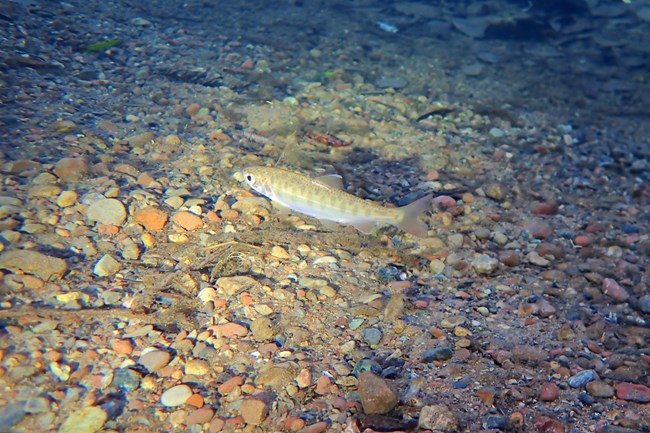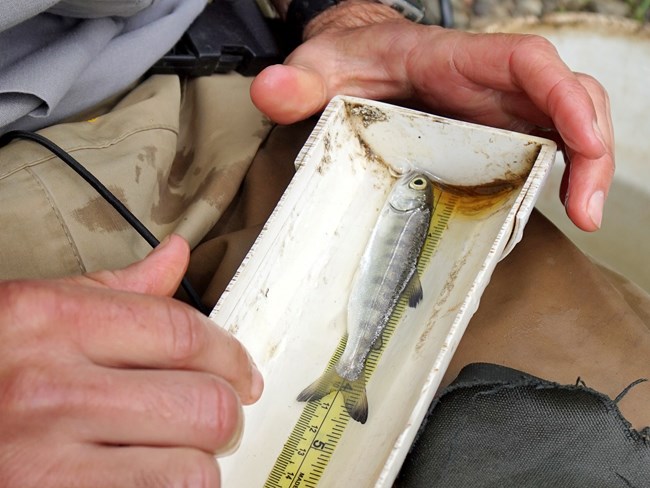Last updated: January 11, 2024
Article
Coho Salmon's Upstream Battle Against Climate Change

NPS / Jessica Weinberg McClosky
December 2022 - A coho salmon valiantly pushes against the current of Olema Creek as winter settles in West Marin. The creek is familiar territory: about 18 months ago, the salmon left this place for the open ocean as a smolt, considerably smaller than she is now. Back then, she let the current wash her downstream toward the feeding grounds of the estuary and then the open ocean. Now, the voyage is not so easy, and the fish has to work her way upstream to find a place to spawn and complete her life cycle. Using up all her energy is worth it: this is a one-way journey, after all.
Coho salmon (Oncorhynchus kisutch) like this one are important members of both freshwater and saltwater ecosystems. As they move through their three-year life cycles, they transport nutrients from ocean to creek and participate in relationships with many other species, including humans. Indigenous people along the West Coast value salmon as a crucial food source, and have such strong relationships with the fish that some groups call themselves Salmon People.
The health of the salmon is tied to the health of the creek, and vice versa. If the creek ecosystem is disturbed, the salmon will suffer. This close relationship allows biologists to monitor the health of the coho salmon population both to support the fish themselves and to indirectly keep track of the health of the creek ecosystem and other animals that live within it.
The female salmon’s upstream journey is a difficult one, but she is lucky to be one of the fish that gets to see it through. At every stage in a salmon’s life cycle, they face perilous challenges and high mortality rates. This has always been true – predators have been around as long as the salmon have, after all – but conditions are growing increasingly challenging because of human disturbances, including manipulation of the environment and anthropogenic climate change.
The population of coho salmon along the central California coast is classified as endangered, and continues to be threatened by human activity. At each of the three main stages in their life cycle, coho suffer from the consequences of humans’ actions.

NPS / Michael Reichmuth
I. Growing in the creek
Three years earlier, the female salmon hatched from an egg in Olema Creek. As a small fish, also known as a fry, she spent upwards of a year in the creek, growing and feeding there.
During this period, fry rely on oxygenated, cold water moving through the stream. They also need places of refuge, like in piles of trees and branches that have fallen into the water, where they can hide from predators and prevent themselves from getting pushed downstream by the current.
But in many places, human development has made creeks less hospitable for young salmon. People have removed woody debris – and therefore hiding places – from the water, or even rerouted streams altogether, disrupting salmon habitat. On the riverbanks, human actions have also harmed native vegetation, which helps keep the water in the creek cold enough for the fish.
Biologists monitoring coho salmon in the San Francisco Bay Area have also seen the impacts of climate change on the young fish’s health. Rising global temperatures spark algae growth that can lower oxygen levels and cause water temperatures to rise in creek habitats. Climate change also increases rates of extreme weather, like severe droughts, which can dry out sections of creek thereby causing juvenile mortality and effectively trapping smolts attempting to migrate out to sea.

NPS / Maritte O'Gallagher
II. Migration and feeding out at sea
After spending a year in the creek, the female coho had grown into a young adult, also known as a smolt, and headed downstream towards the ocean.
Coho tend to stay in the ocean for about 18 months. They eat voraciously and grow larger, at first gaining nutrients from their diet of fatty zooplankton before moving on to larger prey like herring, anchovies, and squid.
Because of climate change, though, the female salmon likely couldn’t find robust food sources in the same way her ancestors did. Warming sea waters and ocean acidification result in the presence of less fatty and therefore less nutritious zooplankton. Other sources of prey may have followed colder currents north, making her swim farther to find them. While in the ocean, it’s important for her to store as much energy as possible. If food sources are less nutrient dense or less abundant, she could easily be too weak to survive the journey back.
III. Returning to spawn
At this point, much larger and stocked up on energy, the salmon joins others near the mouth of Olema Creek to make the journey home. Once the stream flow is high enough, she enters and begins to swim upstream to find a place to spawn. She’s looking for the ideal location to dig a nest, also known as a redd, in the creekbed gravel and lay eggs for males to fertilize. She’ll live as long as she can after spawning before her energy runs out, and she dies.
Erratic rainfall patterns caused by climate change have a large impact on this portion of the coho life cycle. At Redwood Creek in Marin County, CA, for example, if rain doesn’t come until late in the season, salmon must wait offshore for the creek’s mouth to open up – hanging like sitting ducks in the water for predators to pick them off. If there isn’t enough streamflow to keep the creek open to the salmon for long enough, many would-be spawners won’t make it back in time, and may never have a chance to reproduce.
At each stage in her life cycle, the female salmon was lucky to escape the impacts of climate change and human disturbance. Many others were not so fortunate. Overall, populations of coho salmon along the central California coast are suffering, giving park managers the challenging task of protecting them as climate effects continue to accumulate.
Protecting Coho
Reversing the effects of climate change will require major policy shifts on a global scale. Since there’s only so much local parks can do to minimize the effects of climate change on ocean conditions or rainfall, park scientists are focusing on protecting young salmon during their freshwater life stages. By helping them in the first stage of life, scientists can play a role in increasing survival rates, thus allowing the fish to grow as big as possible before they leave for the ocean.
Park managers install artificial wood structures to create deep pools that provide cover for fish and protect them from predators. They also facilitate vegetation restoration projects along the creek, planting native plants and removing invasive ones to improve bank stability and canopy cover near rivers.

NPS / Michael Reichmuth
NPS scientists are hopeful that continued efforts will replenish local coho populations. In the summer of 2022, biologists documented a record number of coho juveniles in Olema Creek, which could lead to another successful season when those fish return to spawn in the 2024-25 winter. Even though the effects of climate change loom large, monitoring and management give this iconic species the best chance they can have at life.
Want to help the salmon? Here are a few ways:
-
Read more about the San Fransisco Bay Area Inventory and Monitoring Network’s salmon monitoring program, and check out their seasonal updates.
-
Practice leave no trace while in nature, and do your part to leave the salmon undisturbed.
-
Volunteer for ecosystem restoration projects through SPAWN, a local advocacy network working to protect aquatic species.
-
And stay tuned for volunteer opportunities through Point Reyes National Seashore!
-
Be aware that creeks are sensitive places. Walking along the creekside can alter salmon habitat through erosion. Following marked trails keeps you and the salmon safe.
-
Appreciate the salmon from safe viewing areas! This park guide gives advice on the best locations to spot coho salmon during the spawning season.
Thank you to Fisheries Field Crew Lead Brentley McNeill and Fisheries Biologist Michael Reichmuth for providing information for this article.
See more from the Bay Area Nature & Science Blog
Tags
- golden gate national recreation area
- muir woods national monument
- point reyes national seashore
- coho salmon
- oncorhynchus kisutch
- salmon
- fish
- climate change
- global warming
- global warming/climate change
- climate crisis
- climate chaos
- sfan
- blog
- climate change effects
- climate change impact
- climate change impacts
- claire baker
- point reyes national seashore association
